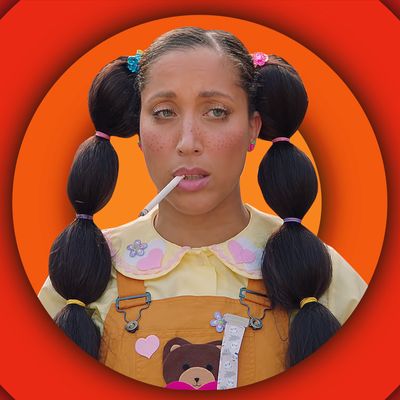
Robin Thede was raised on sketch comedy, with her dad letting her stay up to watch Saturday Night Live every weekend. In Living Color gave the impression that maybe she could do it one day, and by age 12, she had started filming her own sketches. She put together a troupe in college at Northwestern University, and she studied at Second City after graduating. After moving to L.A., she was never not doing sketch comedy, appearing in a number of pilots and short-lived series. That’s why, after her late-night show The Rundown With Robin Thede was canceled by BET in 2018, sketch comedy was her obvious next move. And three seasons in, A Black Lady Sketch Show has proven to be the culmination of all that studying, learning, and performing. For example, “What Up I’m Three,” a season-three standout in which Thede plays a woman playing a baby, took years to build up, and the result is more fun and strange than a one-note sight gag of seeing her in pigtails.
On Good One, Thede discusses the sketch’s rise and fall and rise again; the differences between character-, concept-, and situation-driven sketches; and how to properly begin and end a sketch. You can read an excerpt from the transcript or listen to the full episode below. Tune in to Good One every Thursday on Apple Podcasts, Spotify, Stitcher, Overcast, or wherever you get your podcasts.
I’d been trying to do this sketch for years, because pre-COVID I read this story about a British couple who had adopted a child they thought was in the single digits. It turns out, that child was a grown woman; when she got her period, they were like, Maybe she’s not 6. I was literally mortified — the story itself is actually really sad; I think she tried to murder one of the parents — and also highly entertained.
I pitched an original sketch where I told my writers, “What if there’s a sip-and-see and the mom is convinced that the baby is a child but no one else is?” (It’s something that Black people do with newborns: You sip alcohol, you see the baby.) I came up with the catchphrase where the kid, Annie, just comes in like, “What up, I’m three.” I pitch that to my writers to dead silence. They said, “Something’s wrong with you.” So I wrote a much more layered, steampunk, futuristic adoption version of the sketch, and we read it — again, to complete silence.
The head of comedy at HBO, Amy Gravitt, who I am obsessed with, said, “You gotta do it. It’s hilarious.” But I’m all about impressing my own writers. If they’re not laughing, I’m like, Oh, it’s trash. Then we got shut down in March of 2020, five days before we were shooting season two. By the time we came back in the fall, I was like, Yeah, I’m not going to do that sketch. It requires actual kids. And then, with season three, I thought, Let me go back to the sip-and-see version, where it’s just stripped back and normal. So we have three types of sketch: character-driven, concept-driven, and situation-driven. This sketch is situation-driven. You would think it was character-driven, but it’s not. At first, it was all about Annie: “What up, I’m three.” But she doesn’t really say much more than that. There wasn’t enough meat on the bone. I said, Okay, let me go back to my sketch roots.
Every sketch has a beginning, middle twist, and end. We always start a sketch with a joke. In season one, I thought the pace was a little slow getting in and out of some sketches. Every third line was a joke because that was something I’d heard Tina Fey say back in the day. In the second season, I decided, All right, every other line needs to be a joke. In the third season, I went to, Every line’s a joke. The setup is in the joke, and then the punch line’s in the next joke.
In the initial 35 seconds, when we’re establishing the characters, Skye Townsend’s character, Charlene, says to Gabrielle Dennis’s character, Gerry, “What are you, a finger painting for my baby girl? Because I’m so happy you made it.” Double meaning: made it to the party, made the finger painting right. A simple joke. It’s not going to have you falling out of your chair, but it establishes the mom has a baby she cares about, that she’s obsessed with juvenile things and baby things, that she’s proud of her child, and that she has a really good relationship with Gerry. All in that one joke.
Then the middle twist is introduced right away: You see that I’m not a child, and we’re off to the races. Really, all the jokes come from the absurdity of the situation. Once I realized that I had been pounding my head against the wall because I was writing it as a character sketch, I wrote it as a situation-driven sketch and it sang. Charlene, who is deliriously oblivious to the fact that her child is a grown adult, is trying to convince everyone that the grown adult is a baby. Gerry is trying to convince everyone the opposite. Two immovable forces.
There was an article in The Hollywood Reporter about all the hair on the show. Nikki Wright for our first two seasons and Shavonne Brown for seasons three and four have been geniuses, just geniuses. For Annie, we did the long banded pigtails. Just a really ridiculous play on an adult-looking baby. It’s not hair for hair’s sake. It’s hair for comedy’s sake.
And Ashley Nicole Black’s character, Harlan, is Charlene’s wife but very much just wants to be left out of the conversation — Charlene said, “Yes, we’re going to adopt,” and Harlan was clearly like, “I never said that,” and was very blindsided by the fact that there was now a 3-year-old-slash-30-year-old in the house. Once we figured out she didn’t want kids and truly felt assaulted in her own marriage by the fact that this child was there, it really took shape. We try really hard on the show to not have any, like, typical straight-man character, so we needed Harlan to be a person above this who’s not overreacting, just calling out the fact that everything in this situation is very bad.
And in the end, of course, we find out that Annie is a grown adult masquerading as a child in order to commit burglaries. We really drill down on the inversions of the sketches, and we continue punching them up even in real time. It drives my writers nuts, but if everybody has a really strong comedic game, then the sketch is going to keep you laughing until you’re doubled over and you’re not going to be able to breathe. I want people in pain from laughing.
And then our editors took it up a notch even more: Annie only says, “What up, I’m three” three times in the original sketch. But when we were there on the day, I realized I was improvising it a lot more and saying it with different inflections to mean different things. When you hear Annie say it, she says it a couple of times differently and you’re like, Oh, now she has this emotion. Originally, we had it edited to script, but Stephanie Filo, one of our amazing, Emmy Award–winning editors, goes, “I got it. Let me take another pass.” She just peppered in [seven more] what-up-I’m-threes, and that’s when I said, “That’s the sketch.”
This interview excerpt has been edited and condensed.
More From This Series
- Nate Bargatze Fought Hard for the ‘Washington’s Dream’ Sketch
- Katt Williams Tells the Stories Behind Three of His Best Jokes
- Ego Nwodim Is in Her Silly Season


